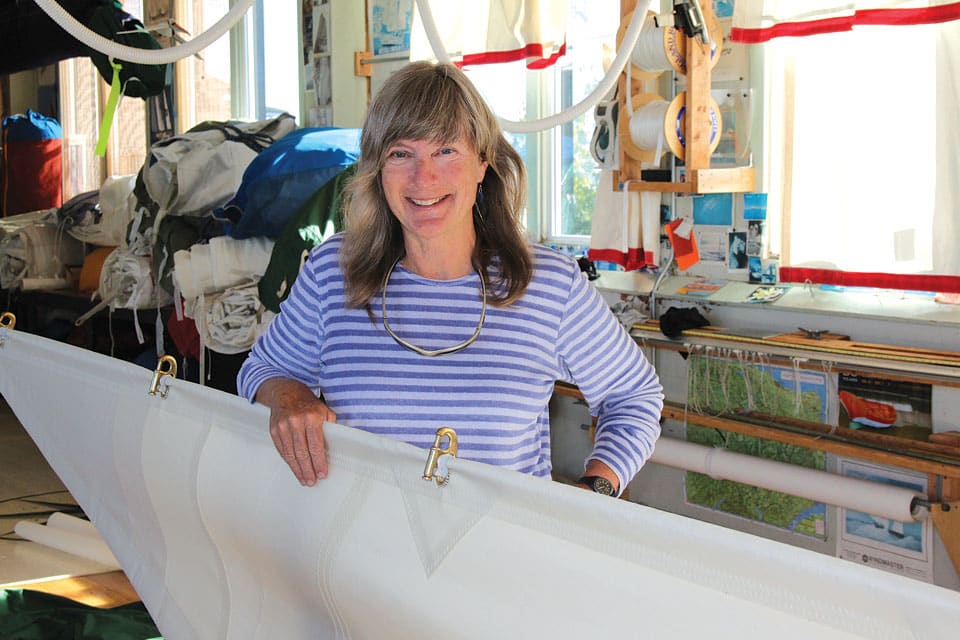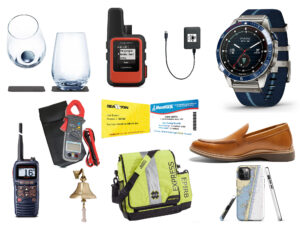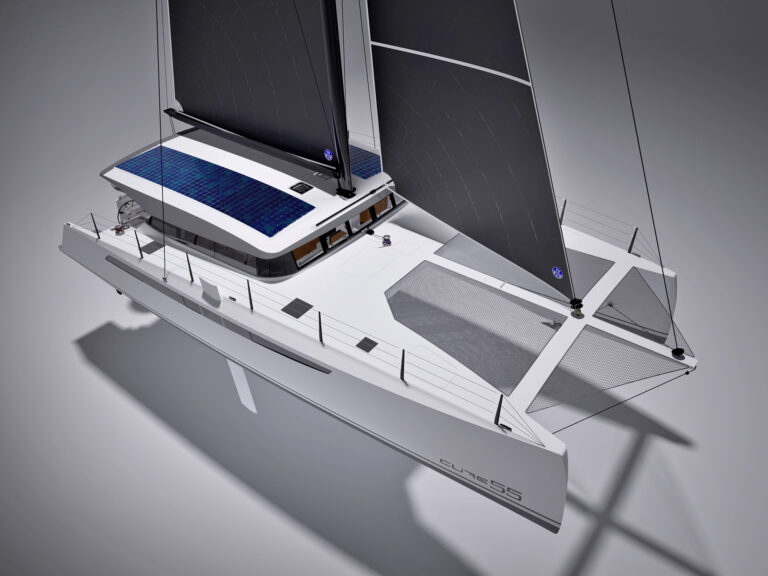
Port Townsend Sails
Valiant 40
The venerable cutter rigged Valiant 40 is served best by mainsail, roller furling genoa, working staysail, storm staysail, and trysail. Adding a cruising spinnaker, drifter, and light air main will keep it moving in zephyrs on all points of sail. Its working and storm sails will last longer and need fewer repairs if they are constructed of a tightly woven “premium” Dacron such as Challenge’s Marblehead. Its light air sails should be made of woven rip-stop Nylon engineered for strength and stability.
The cutter’s large fore-triangle calls for a conservatively sized 115% roller furling genoa of 8.77 ounce Dacron. Constructed with a padded luff, the 115% genoa can be “roller reefed” to an 80% jib-sized sail capable of weather work. The genoa should be cut to clear the bow pulpit and have its clew roughly six feet above the deck to allow visibility forward when heeling, and optimal performance when reaching. The UV cover should be Sunbrella with a Top Gun layer where chafe is unavoidable.
A hanked-on working staysail of 195 sq. ft. should be built of 9.77 ounce Dacron with its clew 5 feet above the deck and just forward of the mast for clearance when the staysail is tacked or back-winded. It will be the first line of defense along with the deeply reefed mainsail in deteriorating conditions.
In storm force winds the working staysail is struck, and the 105 sq. ft. hanked-on storm staysail set. Made of 9.77 ounce Dacron , “purpose built” for heavy weather with a clew 8 feet off the deck and an easily seen fluoro-green “visibility patch”, a storm staysail is more seaworthy than a partially furled headsail. Both working and storm staysails should have a 2 foot tack pendant to prevent lifeline chafe and minimize the possibility of scooping green water.
When light winds prevail, a 1.5 ounce Nylon tri-radial, 165%, asymmetric cruising spinnaker of approximately 1275 square feet is the Valiant’s optimal reaching sail. A spinnaker sleeve makes setting, striking and jibing this sail relatively easy. Often passage makers reduce sail at night or need to sail close to the wind in light air. A 130% drifter made of 2.2 ounce Nylon and fitted with a spectra luff can be set flying just abaft the furled genoa with a spare jib halyard. It can be easily tacked or jibed, and used on all points of sail. Wing and wing, with genoa poled out and the drifter sheet led through a block on the boom, their combined sail area is similar to the cruising spinnaker’s. Handling a free flying drifter can be made easier with a “Code- Zero” furler or ATN’s soft-hoop spinnaker sleeve.
A loose-footed mainsail with four full-length battens (projecting as much roach as possible inside the backstay), two deep reef rows, and a Cunningham cringle is ideal. Using Tides Marine’s Strong Track and luff slides and Schaefer Marine’s adjustable batten-end receptacles ensures easy setting and striking. Securing RBS epoxy resin battens in Top Gun lined platform pockets and through-bolting their aft ends, precludes batten escape or damage. Installing two reef rows that reduce mainsail area by 30% and 60% (rather than the usual three reefs that reduce sail area by 20%, 40%, and 60%) reduces weight, chafe, complexity, and cost. The position and size of the Valiant 40’s mainsail means it derives minimal benefit from the “gear shifts” of three smaller reefs. Lazy jacks that can be secured along the boom when not in use and can leave a clear path for hoisting the trysail are invaluable.
Regardless of reef positions, a trysail of 90 square feet is an essential “spare main”, necessary for heavy weather tactics and for windward work if the main is temporarily disabled.
A sail that also complements the mainsail is a battenless, loose footed, 1.5 ounce Nylon light air mainsail that is capable of reaching or running in very little wind. The light air mainsail is sheeted to the end of the main boom and set flying with a spare mainsail halyard. An ATN “soft-hoop” spinnaker sleeve is a great tool for handling this very useful sail.
Valiant 40—recommended offshore sail inventory
• Roller furling genoa: 115%—530 sq. ft.
• (maximum “to-weather” furl: 370 sq. ft. or 80% of fore-triangle)
• Working stays’l—195 sq. ft.
• Storm stays’l—105 sq. ft.
• Mainsail—306 sq. ft. (not including roach)
• 1st reef—214 sq. ft.
• 2nd reef—122 sq. ft.
• Trysail—90 sq. ft.
• Asymmetric cruising spinnaker: 165%—1275 sq. ft.
• Drifter: 130%—575 sq. ft.
• Light air main sail—306 sq. ft.
Passport 545
The Passport 545’s Solent rig is most versatile and efficient when the workhorse of its headsail inventory—125% roller furling genoa with a padded luff capable of being partially furled to an efficient 85% jib—is flown forward of the Solent stay. The 125% should be built of Challenge’s 10.77 ounce Marblehead premium Dacron for durability, longevity, and ease of maintenance and should have a Sunbrella UV protective cover with Top Gun in high chafe areas.
The Solent stay should be rigged without a furler. It should be a wire stay fitted with a release lever at its deck terminus so it can be cleared from the foredeck to allow for tacking the genoa. In light air, the Solent stay can be rigged and a hanked-on drifter roughly 145% of the Solent triangle can be flown. A drifter is capable of sailing upwind as well as reaching, or it can be flown wing and wing with the genoa. Made of 2.2 ounce nylon, a drifter will inflate easily and require little effort to handle or stow. Nylon also has good shape recovery if carried in higher winds or gusts. Because the drifter is hanked-on, setting and striking is elementary, and because it is flown abaft the headstay it can be tacked.
A 180% asymmetric cruising spinnaker of 1.5 ounce nylon should be onboard, too, and it should be fitted with an ATN spinnaker sleeve for easier handling. An asymmetric chute will not be as weatherly as a drifter, nor will a drifter (or a reacher) be as powerful off the wind as this much larger, free flying sail. These two sails complement each other’s light air capabilities.
In heavy weather, the storm jib can be hanked-on and flown from the Solent stay. This allows the storm jib to have a most effective geometry and eliminates the need for an inner, third stay. The storm jib should be made of 10.77 ounce Marblehead Dacron; it should be scotch cut not cross cut, with a two-ply leech and a fluoro-green visibility patch covering 20% of the sail port and starboard.
In-mast furling mainsails greatly compromise the sailing efficiency of any vessel. That said, any attempt to add roach and the battens necessary to support it generally ends in major repair and a “roachectomy”. A battenless mainsail made of Challenge’s 10.77 ounce Premium Marblehead Dacron, a UV-coated Dacron leech, Sunbrella clew cover, and an Antal clew block will serve most reliably.
A storm trysail of Challenge’s 10.77 ounce Premium Marblehead Dacron with its own mast track is a must to complete a seaworthy sail inventory. This sail provides options for heaving-to, windward work, and service as a steadying sail or a spare mainsail in any circumstance that renders the mainsail unusable.
**Passport 545 tall rig—recommended offshore sail inventory **
• Roller furling genoa: 125%— 755 sq. ft.
• Max “to-weather” furl—525 sq. ft. or 87% fore-triangle
• Drifter (hanked-on): 145% of solent triangle— 760sq. ft.
• Storm Jib (hanked-on)—155sq.ft.
• In- Mast Furling Mainsail—605sq .ft.
• Trysail—180 sq. ft.
• Asymmetric Cruising Spinnaker: 180%—1865 sq. ft.
Port Townsend Sails








